Paper
For submission of articles or Working Papers to CEsA, please send an email to:
comunicacao@cesa.iseg.ulisboa.pt
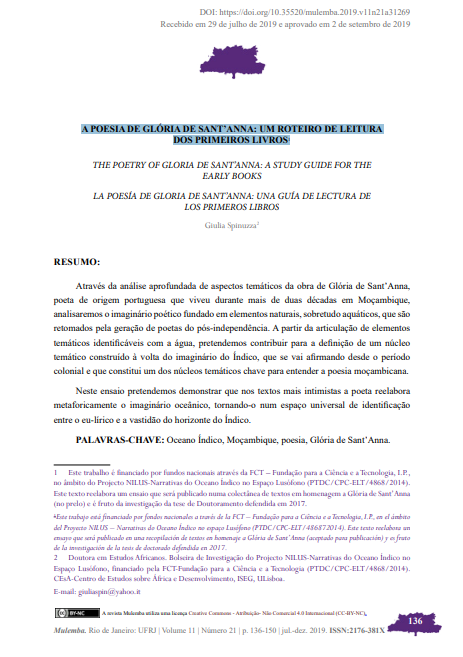
A poesia de Glória de Sant’anna: um roteiro de leitura dos primeiros livros
Abstract:
Through in-depth analysis of thematic aspects of the work of Glória de Sant’Anna, a poet of Portuguese origin who lived for over two decades in Mozambique, we will analyze in A poesia de Glória de Sant’Anna: um roteiro de leitura dos primeiros livros the poetic imaginary based on natural elements, especially aquatic, which are resumed by the generation of post-independence poets. Through the articulation of thematic elements identifiable with water, we intend to contribute to the definition of a thematic core built around the imaginary of the Indian Ocean, which has been asserting itself since the colonial period and which constitutes one of the key thematic cores for understanding Mozambican poetry. In this essay, we intend to demonstrate that in the most intimate texts, the poet metaphorically reworks the oceanic imaginary, turning it into a universal space of identification between the lyric self and the vastness of the Indian Ocean horizon. This work is financed by national funds through FCT – Fundação para a Ciência e a Tecnologia, I.P., under the NILUS-Narratives of the Indian Ocean in the Lusophone Space Project (PTDC/CPC-ELT/4868/2014). This text reworks an essay that will be published in a collection of texts in tribute to Glória de Sant’Anna (in press) and is the result of the research of the PhD thesis defended in 2017.
Quotation:
“Spinuzza, Giulia. A poesia de Glória de Sant’Anna: um roteiro de leitura dos primeiros livros. Mulemba, UFRJ, Brasil, vol. 11, n. 21, Dezembro 2019, p. 136 https://revistas.ufrj.br/index.php/mulemba/issue/view/1302/showToc”

Entre silêncios e interferências: mulheres na imprensa colonial
Abstract:
In Entre silêncios e interferências: mulheres na imprensa periódica colonial we adress the presence of women in the colonial periodical press of the former Portuguese Empire means trying to define, even if only provisionally, the main aspects of the “object” of reflection proposed in the present dossier. Firstly, by proposing a joint approach, under the term “colonial”, of the periodical press published both in the former metropolis and in the various spaces colonised by Portugal, we point to some perspectives of the historiography on European colonialisms which have been shattering polarized visions, analysing the social and political reverberations between metropolis and colonies, the transits of ideas and imaginaries, as well as the “manufactured” dimension of the difference (Burton 1994; Cooper and Stoler 1997). The dossier results from the panel “The ‘women’ and the colonial periodical press” organized in the framework of the International Congress Politics and Culture in the Colonial Periodical Press, which took place from 22 to 25 May 2017, near the CHAM-Centre of Humanities of the New University of Lisbon, in partnership with the CEI-IUL-Centre of International Studies of ISCTE-Instituto Universitário de Lisboa and the CEC-Centre of Comparative Studies of the Faculty of Letters of the University of Lisbon. The Congress was an initiative of the International Study Group of the Colonial Periodical Press of the Portuguese Empire, created by Sandra Ataíde Lobo (CHAM-UNL), Adelaide Vieira Machado (CHAM-UNL) and Cátia Miriam Costa (CEI-IUL). Various entities and researchers from different research centres have joined the Group.
Quotation:
“Falconi, J.; Wieser, D. (2019). Entre silêncios e interferências: mulheres na imprensa periódica colonial, Revista ex aequo- Revista da Associação Portuguesa de Estudos sobre as Mulheres, n. 39. https://doi.org/10.22355/. exaequo.2019.39.01.10.22355/”
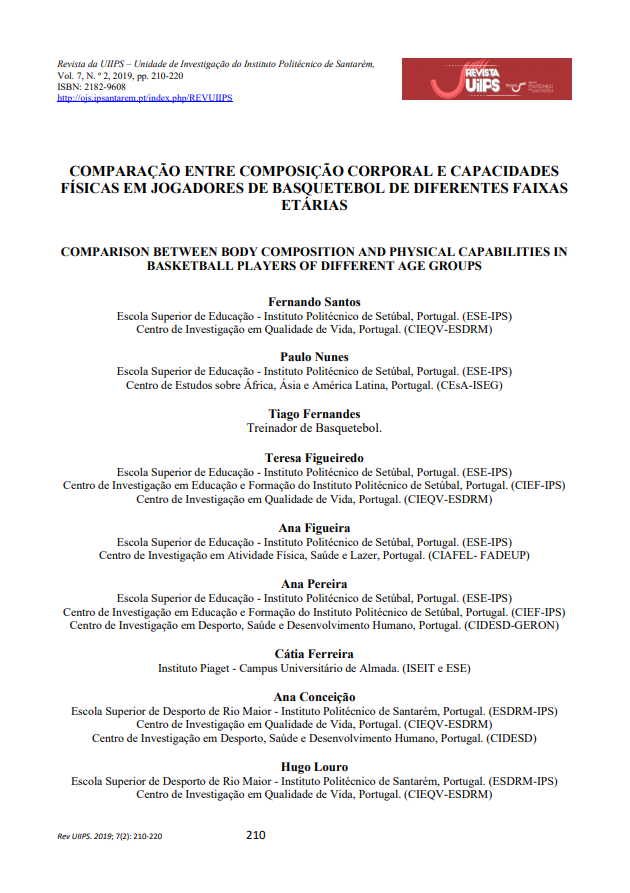
Comparação entre composição corporal e capacidades físicas em jogadores de basquetebol de diferentes faixas etárias
Abstract:
The aim of Comparação entre composição corporal e capacidades físicas em jogadores de basquetebol de diferentes faixas etárias was to compare the relationship between body composition and physical abilities in basketball players aged 12-13 and 14-15 years old. Twenty-four basketball players from a team in the Setúbal Peninsula were involved in the study, twelve belonging to each age group. The involvement of young people and adolescents in regular sports practice has evolved in modern society, and the consensual references in the literature of benefits related to sports practice at physical and cognitive level contribute to this. They made evaluations related to body composition and strength of lower and upper limbs. Correlations were observed between body composition and handgrip strength and an inverse relationship between groups between handgrip strength and countermovement jumping. The muscle mass, showed a close relationship with handgrip strength in both age groups. It is fundamental to evaluate and control the training in the most varied age groups in basketball in order to detect talent, to improve the training prescription and to improve the sport performance.
Quotation:
Santos, F., Nunes, P., Fernandes, J., Figueiredo, T., Figueira, A., Pereira, A., Ferreira, C., Conceição, A., Louro, H., & Espada, M. (2019). Comparação entre composição corporal e capacidades físicas em jogadores de basquetebol de diferentes faixas etárias. Revista UIIPS, 7(2), 210-220.
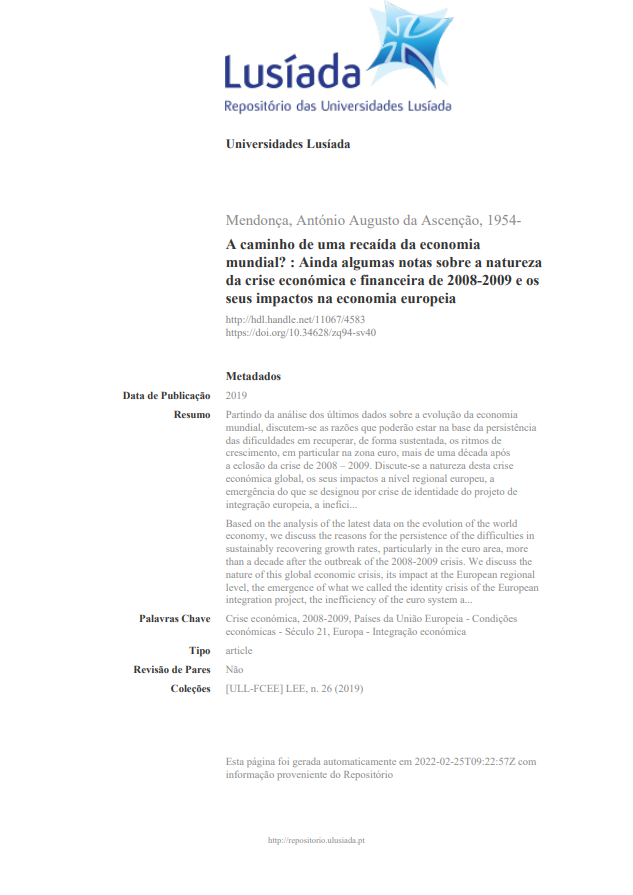
A Caminho de uma Recaída da Economia Mundial? Ainda Algumas Notas sobre a Natureza da Crise Económica e Financeira de 2008-2009 e os seus Impactos na Economia Europeia
Abstract:
Based on the analysis of the latest data on the evolution of the world economy, the reasons that may underlie the persistence of the difficulties in recovering, in a sustained manner, the rates of growth, particularly in the euro zone, more than a decade after the outbreak of the crisis of 2008-2009, are discussed. The nature of this global economic crisis is discussed in A caminho de uma recaída da economia mundial? : Ainda algumas notas sobre a natureza mundial? : Ainda algumas notas sobre a natureza da crise económica e financeira de 2008-2009 e os seus impactos na economia europeia, its impacts at the European regional level, the emergence of what has been called an identity crisis of the European integration project, the inefficiency of the euro system as an adjustment mechanism, internal and external, and the role of unconventional monetary policy. The conclusion is that Europe needs to undertake a profound redefinition of its integration project, including the redesign of the euro system in light of the recent experience of unconventional monetary policy. In this process, it is considered that there is an important place for Portugal, as an Atlantic European country, whose identity was formed and consolidated in the process of constitution of the global economy.
Quotation:
Mendonça, António .2019. A caminho de uma recaída da economia mundial?: Ainda algumas notas sobre a natureza mundial?: Ainda algumas notas sobre a natureza da crise económica e financeira de 2008-2009 e os seus impactos na economia europeia”, Lusíada – Economia & Empresa, nº 26, p. 31-66
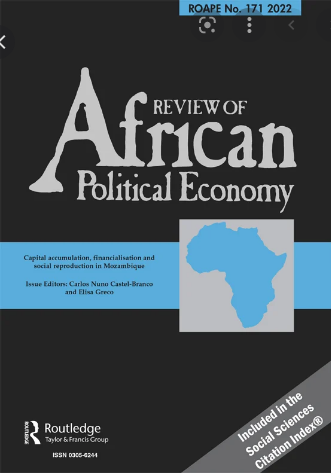
Class, politics and dynamic accumulation processes around the Sino-Mozambican rice project in the lower Limpopo, 2005–2014
Class, politics and dynamic accumulation processes around the Sino-Mozambican rice project in the lower Limpopo, 2005–2014 by Ana Sofia Ganho levels a Marxist political economy lens at the development of the Sino-Mozambican rice project in the lower Limpopo valley. Focusing on a defined time period, 2005–14, it interrogates the ways that class dynamics shaped, and were shaped by, China’s development cooperation model for Mozambique, and examines changing Mozambican accumulation interests in the context of sudden price rises in agricultural commodities. The article aims to understand how this project relates to Mozambique’s dominant strategy for capital accumulation, such as the dynamics it has enabled for capitalist factions in power. But it also seeks to comprehend the rural differentiation dynamics that the project has generated, particularly with regard to the desideratum to create a new group of rural capitalists. Together with historically situated challenges, this can provide crucial information about the form(s) that the agrarian question of transition to a capitalist agriculture is taking in Mozambique.
Abstract:
This study levels an international political economy lens at the development of the Sino-Mozambican rice project in the lower Limpopo, by examining how class relations shaped and were shaped by global trends, Chinese resources and Mozambican dynamic accumulation interests. The paper argues that the project has served the expansionist interests of the ruling capitalist group associated with central government circles, limiting land-based possibilities at province level. In addition, the plan to locally transform small producers into rural capitalists through ‘modern’ Chinese methods has failed to confront the historical interdependence of the commercial and so-called family sectors and the diversity of livelihood sources for the reproduction of food and labour.
Quotation:
Ganho, Ana Sofia (2022) Class, politics and dynamic accumulation processes around the Sino-Mozambican rice project in the lower Limpopo, 2005–2014, Review of African Political Economy, 49:171, 107-137, DOI: 10.1080/03056244.2022.2050557
Access the article here.

Financialization, narrow specialization of production and capital accumulation in Mozambique
In post-independence Mozambique, national capitalism developed from the ashes of state-centred accumulation built around the dominant social structures of production that were inherited from colonialism. These very specific historical conditions weighed heavily on the structures of accumulation, which later were subjected to neoliberal economic reforms, becoming heavily dependent on inflows of private international finance and resulting in growing financialisation of the economy and of the state, alongside increasingly narrow specialisation of production. Narrow specialisation, also called primarisation, consists in the reduction of the number of industries, sectors, activities and products; the concentration of production and trade around a smaller range of primary commodities for export; increasingly basic and simple production processes, products and levels of processing and articulation; and fewer options and capabilities to promote linkages. In turn, financialisation and primarisation reinforced each other in an increasingly speculative mode of accumulation. Starting from the specific analysis of the historical logic of the mode of capital accumulation in Mozambique (Castel-Branco, 2022), Financialization, narrow specialization of production and capital accumulation in Mozambique by Carlos Nuno Castel-Branco and Diogo Maia will demonstrate the dynamics of financialisation and of the growing primarisation of production, and the connection between the two.
Abstract:
The article argues that the historical conditions under which national capitalism developed in post-independence Mozambique pushed the economy towards growing financialisation and narrower specialisation of production around increasingly basic and simple activities. The paper argues that changing these dynamics of accumulation requires conscious industrial strategies focused on diversification and articulation of production, which cannot be achieved without challenging the extractive mode of accumulation and the power relationships associated with it.
Quotation:
Castel-Branco, Carlos Nuno; and Diogo Maia. 2022. “Financialization, narrow specialization of production and capital accumulation in Mozambique”. Review of African Political Economy, VOL. 49, NO. 171, 46-66 https://doi.org/10.1080/03056244.2022.2049143
Access the article here.

Mozambique – neither miracle nor mirage
Mozambique – neither miracle nor mirage by Carlos Nuno Castel-Branco and Elisa Greco explores how over two decades, in the 1990s and 2000s, international organisations, development cooperation agencies, financial institutions and the media often described the Mozambican economic, social and political trajectory as a ‘miracle’. Hailed as the ‘rising star’ of Africa in 2005 by the New York Times (2005) and by The Economist, the country has long been praised by neoliberal institutions as a model reformer, open and attractive to foreign direct investment (FDI), and for its high rates of economic growth, soaring primary commodity exports and one-digit inflation. While a milder version of this image of a Mozambican ‘miracle’ persisted throughout the 2010s, it started to clash with the reality of worsening inequality, poverty and crisis in social reproduction, as well as the emergence of the first clear signs of a debt crisis yet to come. In the main cities, violent riots triggered by rising costs of basic wage goods and services, over and above average inflation, erupted in February 2008 and again in September 2010. In September 2010, The Economist described these riots as the revolt of the ‘angry poor’, which did not deter international financial think tanks and media from continuing to emphasise the Mozambican ‘miracle’ (The Economist 2010). The country saw the contradiction of worsening poverty, high aid dependency and inequality at the same time as it was being described by the Financial Times as ‘at the centre of unprecedented international investor attention’ (Financial Times 2012, 2010). In May 2014, in her speech to the Africa Rising conference held in Maputo, IMF Managing Director Christine Lagarde highlighted Mozambique’s impressive performance with respect to economic growth as being the result of decades of institution building and sound macroeconomic management, which justified the IMF’s formal permission for Mozambique to obtain new loans on non-concessional terms (Orre and Rønning 2017). Two years later, in 2016, The Economist highlighted the country’s soaring sovereign debt in a context of increasing FDI and aid inflows, and the creditworthiness of the Mozambican economy was downgraded by credit rating agencies from stable average, where it had been from 2003 to 2015, to severe risk of default (Castel-Branco 2020). How can we make sense of this somehow contradictory information? Is Mozambique a ‘miracle’ or a ‘mirage’?
Abstract:
Editorial of the special issue of the Review of African Political Economy (RoAPE), titled “Capital accumulation, financialisation and social reproduction in Mozambique”, volume 49, number 171, March 2022.
Quotation:
Castel-Branco, Carlos Nuno; and Elisa Greco. 2022. “Mozambique – neither miracle nor mirage”. Review of African Political Economy, VOL. 49, NO. 171, 1-10, https://doi.org/10.1080/03056244.2022.2047297
Access the article here,

The historical logic of the mode of capital accumulation in Mozambique
This article by Carlos Nuno Castel-Branco investigates the historical logic of the mode of capital accumulation in Mozambique. By historical logic we mean the objective explanation of the specific characteristics based on an understanding of the country’s historical foundations, and the conflicts and tensions within and related to its structures of accumulation.
Abstract:
This article critically analyses the political economy dynamics and trajectory of the mode of capital accumulation in post-independence Mozambique, focusing on the capitalist restructuring that followed the adoption of the Washington Consensus from the late 1980s. The article highlights the main structural characteristics, dynamics and tensions in the economy, the relationships and conflicts that explain why they reproduce and expand, what makes them change and the nature of the crises that emerge. The argument is that the recent trajectory of the Mozambican economy was not inevitable, and that it can be logically understood and derived from the existing historical conditions of accumulation. Understanding this historical logic enables us to articulate socially transformative actions which are drawn from the objective and concrete analysis of the mode of accumulation and its contradictions, countering idealistic perspectives in political economy.
Quotation:
Castel-Branco, Carlos Nuno. 2022. “The historical logic of the Mode of Capital Accumulation in Mozambique”. Review of African Political Economy, VOL. 49, NO. 171, 11–45 https://doi.org/10.1080/03056244.2022.2040225
Access the article here.
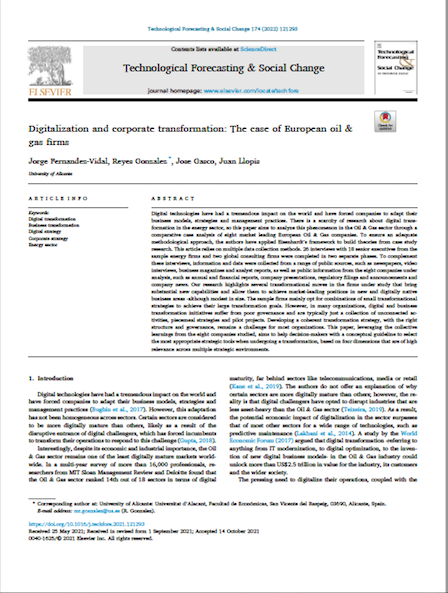
Digitalization and Corporate Transformation: the case of European oil & gas firms
Digitalization and corporate transformation: The case of European oil & gas firms by Jorge Fernandez-Vidal, Reyes Gonzalez, Jose Gasco e Juan Llopis, leveraging the collective learnings from the eight companies studied, aims to help decision-makers with a conceptual guideline to select the most appropriate strategic tools when undergoing a transformation, based on four dimensions that are of high relevance across multiple strategic environments.
Abstract:
Digital technologies have had a tremendous impact on the world and have forced companies to adapt their business models, strategies and management practices. There is a scarcity of research about digital transformation in the energy sector, so this paper aims to analyze this phenomenon in the Oil & Gas sector through a comparative case analysis of eight market leading European Oil & Gas companies. To ensure an adequate methodological approach, the authors have applied Eisenhardt’s framework to build theories from case study research. This article relies on multiple data collection methods. 26 interviews with 18 senior executives from the sample energy firms and two global consulting firms were completed in two separate phases. To complement these interviews, information and data were collected from a range of public sources, such as newspapers, video interviews, business magazines and analyst reports, as well as public information from the eight companies under analysis, such as annual and financial reports, company presentations, regulatory filings and announcements and company news. Our research highlights several transformational moves in the firms under study that bring substantial new capabilities and allow them to achieve market-leading positions in new and digitally native business areas -although modest in size. The sample firms mainly opt for combinations of small transformational strategies to achieve their large transformation goals. However, in many organizations, digital and business transformation initiatives suffer from poor governance and are typically just a collection of unconnected activities, piecemeal strategies and pilot projects. Developing a coherent transformation strategy, with the right structure and governance, remains a challenge for most organizations. This paper, leveraging the collective learnings from the eight companies studied, aims to help decision-makers with a conceptual guideline to select the most appropriate strategic tools when undergoing a transformation, based on four dimensions that are of high relevance across multiple strategic environments.
Quotation:
Jorge Fernandez-Vidal, Reyes Gonzalez, Jose Gasco, Juan Llopis, Digitalization and corporate transformation: The case of European oil & gas firms, Technological Forecasting and Social Change, Volume 174, 2022, 121293, ISSN 0040-1625
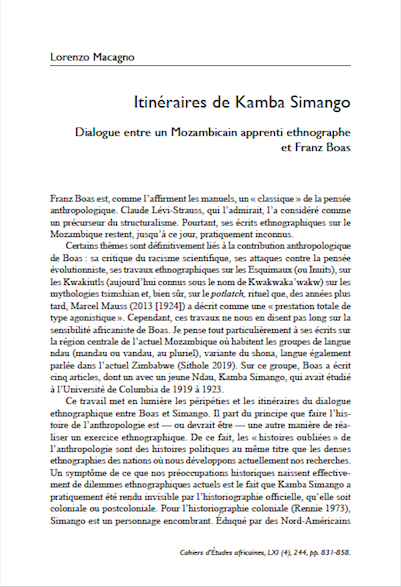
Itinéraires de Kamba Simango: dialogue entre un Mozambicain apprenti ethnographe et Franz Boas
Itinéraires de Kamba Simango: dialogue entre un Mozambicain apprenti ethnographe et Franz Boas by Lorenzo Macagno explores the dialogue between anthropologist Franz Boas and Kamba Simango. It also analyses the ethnographic relationship between them and Simango’s cosmopolitan trajectory.
Abstract:
This paper explores the dialogue between anthropologist Franz Boas and Kamba Simango. Simango was born in 1890, in Machanga District, on the coast of present-day Mozambique. In 1914, under the auspices of missionaries of the American Board of Missions, he was sent to the United States to study at the Hampton Institute. Kamba Simango and Franz Boas met for the first time in 1919 at Columbia University. Boas did not want Simango to become a mere “informant,” but a native ethnographer. Based on an exchange of unpublished letters and a series of documents published mainly by missionaries, this article analyzes the ethnographic relationship between Boas and Simango as well as his cosmopolitan trajectory. Kamba Simango’s life and career help us to understand the colonial experience par le bas, and to understand the construction of subjectivities and specific historicities from a less nation-centered perspective.
Quotation:
Lorenzo Macagno, « Itinéraires de Kamba Simango : dialogue entre un Mozambicain apprenti ethnographe et Franz Boas », Cahiers d’études africaines, 244 | 2021, 831-858. URL: https://www.repository.utl.pt/handle/10400.5/22949





